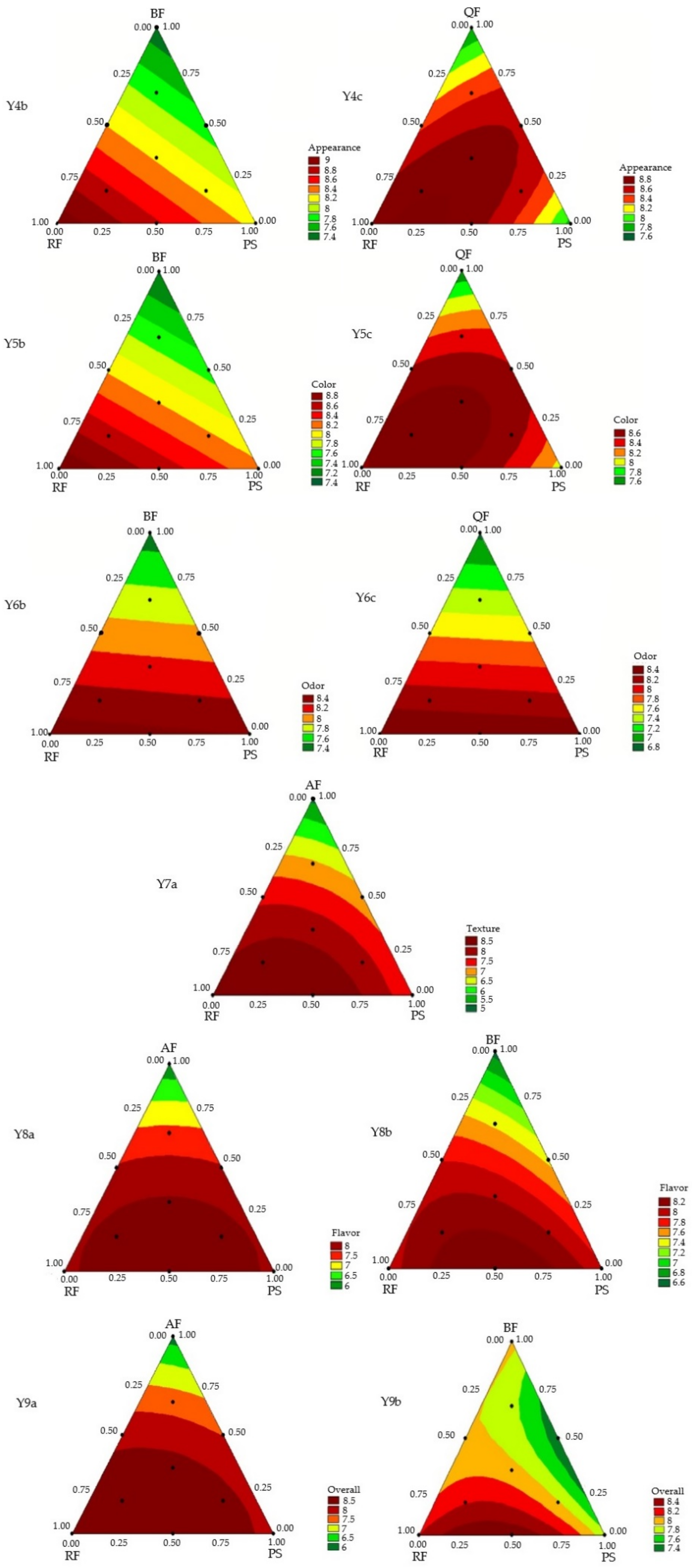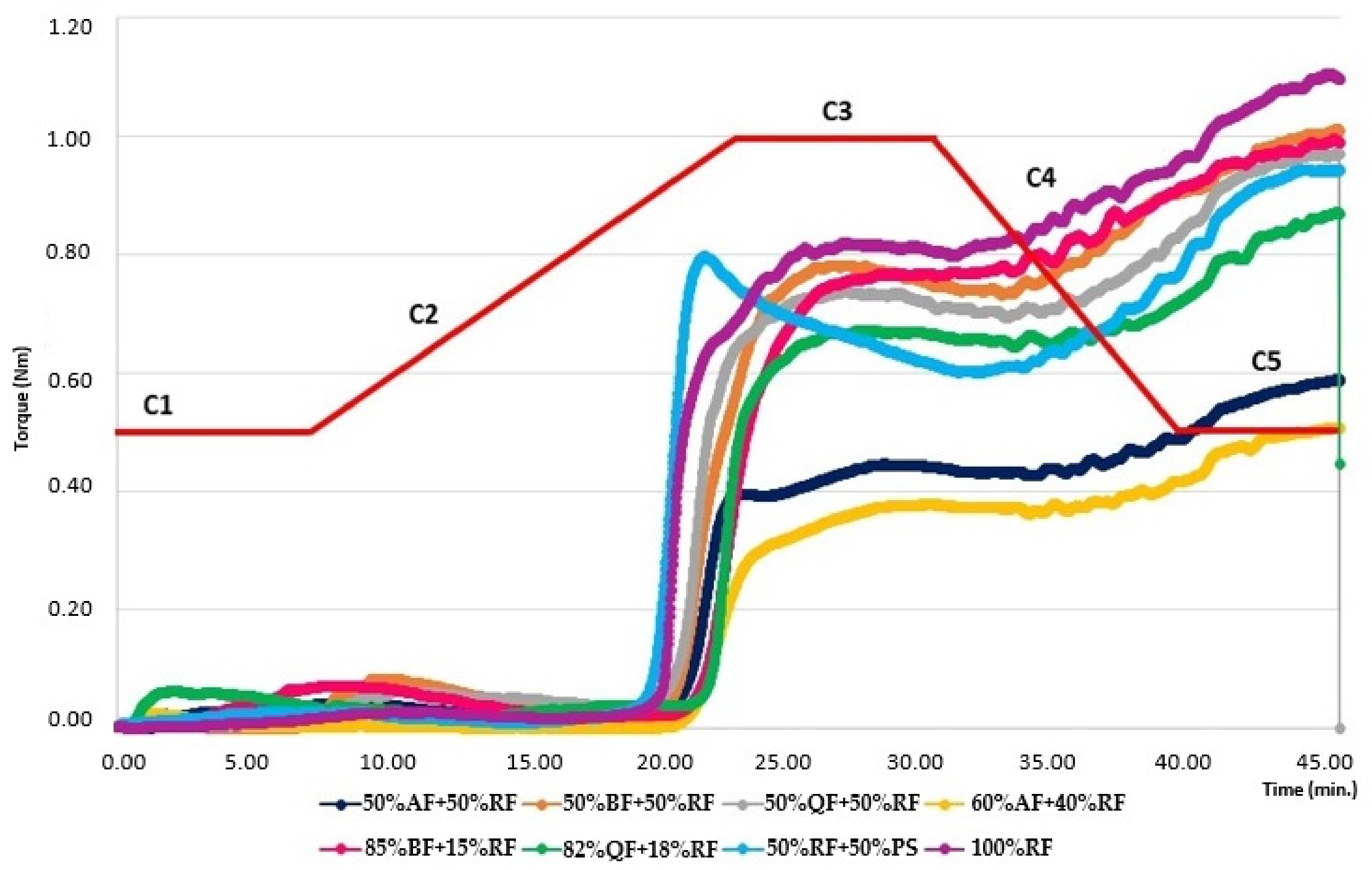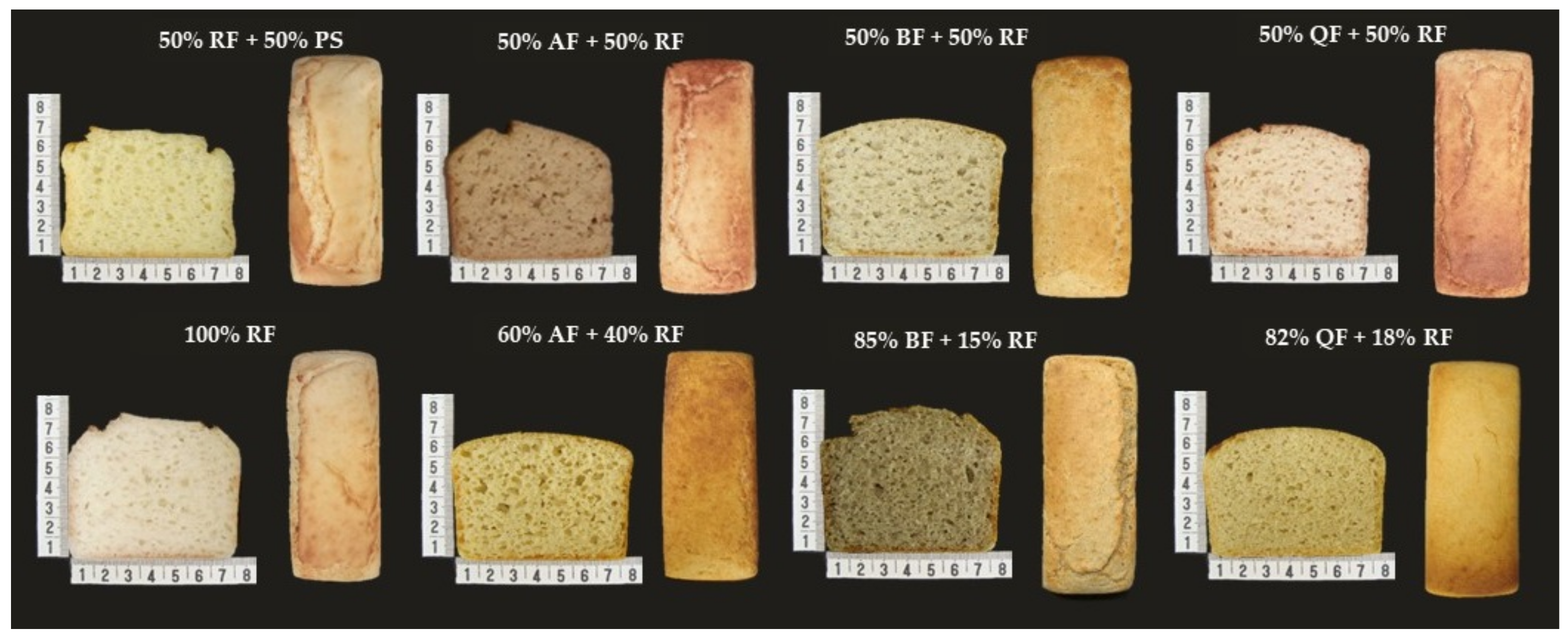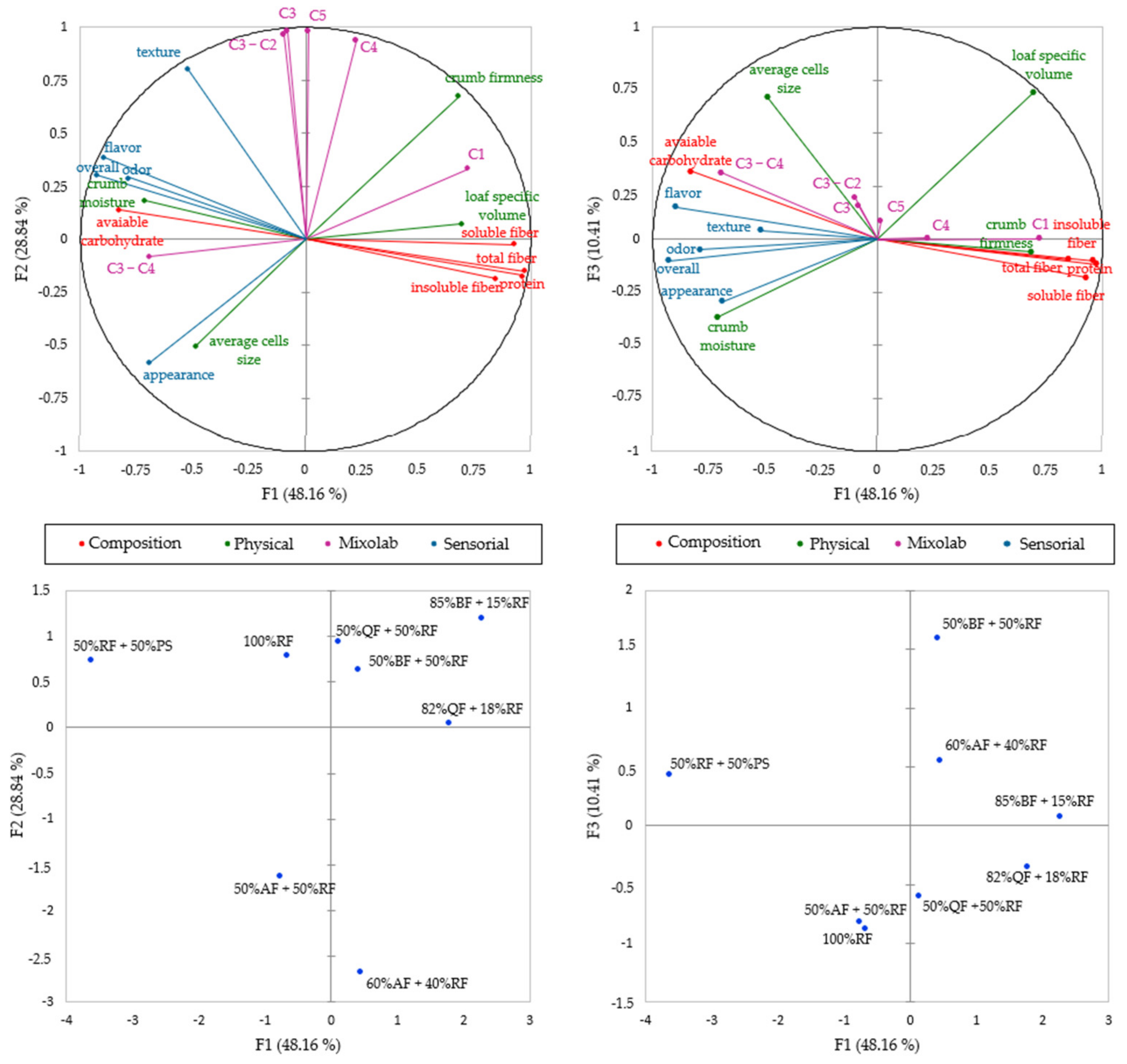Defining Amaranth, Buckwheat and Quinoa Flour Levels in Gluten-Free Bread: A Simultaneous Improvement on Physical Properties, Acceptability and Nutrient Composition through Mixture Design
Abstract
:1. Introduction
2. Materials and Methods
2.1. Ingredients
2.2. Methods
2.2.1. Formulation and Production of Gluten-Free Breads
2.2.2. Experimental Design
2.2.3. Bread Quality Evaluation
2.2.4. Selection of Samples and Quality Verification
2.2.5. Characterization of Selected Samples
2.2.6. Ethical Considerations
2.2.7. Statistical Analysis
3. Results
3.1. Mixture Design and Response Surface Analysis
3.2. Optimal Gluten-Free Bread Formulations
3.2.1. Characterization of Selected Samples
Dough Thermomechanical Properties
Physical Properties and Acceptability Evaluation
Proximate Composition Evaluation
3.3. Relationships between Dough Properties and Instrumental and Sensory Parameters of GFB
4. Conclusions
Supplementary Materials
Author Contributions
Funding
Institutional Review Board Statement
Informed Consent Statement
Data Availability Statement
Acknowledgments
Conflicts of Interest
References
- Grand View Research. Gluten-Free Products Market Size, Share and Trends Analysis Report by Product (Bakery Products, Dairy/DairyAlternatives), by Distribution Channel (Grocery Stores, MassMerchandiser), by Region, and Segment Forecasts, 2020–2027; Grand View Research: San Francisco, CA, USA, 2020. [Google Scholar]
- Do Nascimento, A.B.; Fiates, G.M.R.; Dos Anjos, A.; Teixeira, E. Gluten-free is not enough—Perception and suggestions of celiac consumers. Int. J. Food Sci. Nutr. 2014, 65, 394–398. [Google Scholar] [CrossRef] [PubMed]
- Alencar, N.M.M.; de Araújo, V.A.; Faggian, L.; Araújo, M.B.D.S.; Capriles, V.D. What about gluten-free products? An insight on celiac consumers’ opinions and expectations. J. Sens. Stud. 2021, 36, e12664. [Google Scholar] [CrossRef]
- Capriles, V.D.; Santos, F.G.; Aguiar, E.V. Innovative gluten-free breadmaking. In Trends in Wheat and Bread Making, 30th ed.; Galanakis, C., Ed.; Academic Press: Cambridge, MA, USA; Elsevier: Amsterdam, The Netherlands, 2021; pp. 371–404. [Google Scholar]
- Aguiar, E.V.; Santos, F.G.; Krupa-Kozak, U.; Capriles, V.D. Nutritional facts regarding commercially available gluten-free bread worldwide: Recent advances and future challenges. Crit. Rev. Food Sci. Nutr. 2021, 1–13. [Google Scholar] [CrossRef] [PubMed]
- Capriles, V.; Santos, F.G.; Arêas, J.A.G. Gluten-free breadmaking: Improving nutritional and bioactive compounds. J. Cereal Sci. 2016, 67, 83–91. [Google Scholar] [CrossRef]
- Woomer, J.S.; Adedeji, A.A. Current applications of gluten-free grains—A review. Crit. Rev. Food Sci. Nutr. 2020, 61, 14–24. [Google Scholar] [CrossRef]
- Martínez-Villaluenga, C.; Peñas, E.; Hernández-Ledesma, B. Pseudocereal grains: Nutritional value, health benefits and current applications for the development of gluten-free foods. Food Chem. Toxicol. 2020, 137, 111178. [Google Scholar] [CrossRef]
- Alvarez-Jubete, L.; Arendt, E.K.; Gallagher, E. Nutritive value and chemical composition of pseudocereals as gluten-free ingredients. Int. J. Food Sci. Nutr. 2009, 60, 240–257. [Google Scholar] [CrossRef]
- Alvarez-Jubete, L.; Auty, M.; Arendt, E.K.; Gallagher, E. Baking properties and microstructure of pseudocereal flours in gluten-free bread formulations. Eur. Food Res. Technol. 2009, 230, 437–445. [Google Scholar] [CrossRef]
- Alvarez-Jubete, L.; Arendt, E.K.; Gallagher, E. Nutritive value of pseudocereals and their increasing use as functional gluten-free ingredients. Trends Food Sci. Technol. 2010, 21, 106–113. [Google Scholar] [CrossRef]
- Burešová, I.; Tokár, M.; Mareček, J.; Hřivna, L.; Faměra, O.; Šottníková, V. The comparison of the effect of added amaranth, buckwheat, chickpea, corn, millet and quinoa flour on rice dough rheological characteristics, textural and sensory quality of bread. J. Cereal Sci. 2017, 75, 158–164. [Google Scholar] [CrossRef]
- Alencar, N.M.M.; Steel, C.J.; Alvim, I.D.; de Morais, E.C.; Bolini, H. Addition of quinoa and amaranth flour in gluten-free breads: Temporal profile and instrumental analysis. LWT Food Sci. Technol. 2015, 62, 1011–1018. [Google Scholar] [CrossRef]
- Drub, T.F.; dos Santos, F.G.; Centeno, A.C.L.S.; Capriles, V.D. Sorghum, millet and pseudocereals as ingredients for gluten-free whole-grain yeast rolls. Int. J. Gastron. Food Sci. 2020, 23, 100293. [Google Scholar] [CrossRef]
- Capriles, V.D.; Arêas, J.A.G. Novel Approaches in Gluten-Free Breadmaking: Interface between Food Science, Nutrition, and Health. Compr. Rev. Food Sci. Food Saf. 2014, 13, 871–890. [Google Scholar] [CrossRef]
- Aguiar, E.V.; Santos, F.G.; Centeno, A.C.L.S.; Capriles, V.D. Influence of pseudocereals on gluten-free bread quality: A study integrating dough rheology, bread physical properties and acceptability. Food Res. Int. 2021, 150, 110762. [Google Scholar] [CrossRef]
- AACC. Approved Methods of Analysis; AACC: Washington, DC, USA, 2010. [Google Scholar]
- Santos, F.G.; Aguiar, E.V.; Centeno, A.C.L.; Rosell, C.M.; Capriles, V.D. Effect of added psyllium and food enzymes on quality attributes and shelf life of chickpea-based gluten-free bread. LWT 2020, 134, 110025. [Google Scholar] [CrossRef]
- Villanueva, N.D.; Petenate, A.J.; Da Silva, M.A. Performance of three affective methods and diagnosis of the ANOVA model. Food Qual. Prefer. 2000, 11, 363–370. [Google Scholar] [CrossRef]
- Santos, F.G.; Aguiar, E.V.; Rosell, C.M.; Capriles, V.D. Potential of chickpea and psyllium in gluten-free breadmaking: Assessing bread’s quality, sensory acceptability, and glycemic and satiety indexes. Food Hydrocoll. 2021, 113, 106487. [Google Scholar] [CrossRef]
- AOAC—Association of Official Analytical Chemists. Official Methods of the AOAC International, 18th ed.; Association of Official Analytical Chemists: Rockville, MD, USA, 2005. [Google Scholar]
- Fratelli, C.; Muniz, D.G.; Santos, F.G.; Capriles, V.D. Modelling the effects of psyllium and water in gluten-free bread: An approach to improve the bread quality and glycemic response. J. Funct. Foods 2018, 42, 339–345. [Google Scholar] [CrossRef]
- Fratelli, C.; Santos, F.; Muniz, D.; Habu, S.; Braga, A.; Capriles, V. Psyllium Improves the Quality and Shelf Life of Gluten-Free Bread. Foods 2021, 10, 954. [Google Scholar] [CrossRef]
- Avanza, M.; Puppo, M.; Añón, M. Rheological characterization of amaranth protein gels. Food Hydrocoll. 2005, 19, 889–898. [Google Scholar] [CrossRef]
- Föste, M.; Nordlohne, S.D.; Elgeti, D.; Linden, M.H.; Heinz, V.; Jekle, M.; Becker, T. Impact of quinoa bran on gluten-free dough and bread characteristics. Eur. Food Res. Technol. 2014, 239, 767–775. [Google Scholar] [CrossRef]
- Collar, C.; Santos, E.; Rosell, C.M. Significance of Dietary Fiber on the Viscometric Pattern of Pasted and Gelled Flour-Fiber Blends. Cereal Chem. J. 2006, 83, 370–376. [Google Scholar] [CrossRef]
- Wronkowska, M.; Haros, M.; Soral-Śmietana, M. Effect of Starch Substitution by Buckwheat Flour on Gluten-Free Bread Quality. Food Bioprocess Technol. 2012, 6, 1820–1827. [Google Scholar] [CrossRef] [Green Version]
- De la Hera, E.; Rosell, C.M.; Gomez, M. Effect of water content and flour particle size on gluten-free bread quality and digestibility. Food Chem. 2014, 151, 526–531. [Google Scholar] [CrossRef] [Green Version]
- Matos, M.E.; Rosell, C.M. Quality Indicators of Rice-Based Gluten-Free Bread-Like Products: Relationships Between Dough Rheology and Quality Characteristics. Food Bioprocess Technol. 2012, 6, 2331–2341. [Google Scholar] [CrossRef] [Green Version]
- Codex Alimentarius Comission. Guidelines for Use of Nutritionand Health Claims—CAC/GL 23-1997; Codex Alimentarius Comission: Rome, Italy, 2013. [Google Scholar]





| Design b | Predicted Model Equations c | R2adj (%) d | Model (p) e | Lack of Fit (p) e |
|---|---|---|---|---|
| Loaf specific volume cm3/g (Y1) | ||||
| A | Y1a = 1.74RF + 1.43PS + 1.57AF + 0.65RF × PS + 1.42PS × AF | 86.79 | 0.002 | 0.281 |
| B | Y1b = 1.83RF + 1.59PS + 2.01BF | 32.61 | 0.069 | 0.017 |
| C | Y1c = 1.72RF + 1.43PS + 1.46QF + 1.11RF × QF + 1.30PS × QF | 80.18 | 0.007 | 0.063 |
| Crumb firmness N (Y2) | ||||
| A | Y2a = 9.88RF + 9.31PS + 4.31AF | 73.62 | 0.001 | 0.749 |
| B | Y2b = 10.19RF + 11.13PS + 22.69BF | 70.82 | 0.002 | 0.004 |
| C | Y2c = 8.84RF + 8.97PS + 20.99QF | 83.75 | 0.000 | 0.277 |
| Crumb moisture % (Y3) | ||||
| A | Y3a = 52.28RF + 55.43PS + 53.75AF | 98.19 | 0.000 | 0.137 |
| B | Y3b = 51.59RF + 55.00PS + 52.11BF | 78.63 | 0.000 | 0.014 |
| C | Y3c = 52.56RF + 55.63PS + 54.02QF | 83.17 | 0.000 | 0.461 |
| Appearance acceptability score (Y4) | ||||
| A | Y4a = 8.73RF + 7.71PS + 7.25AF + 2.64RF × PS+ 3.46PS × AF | 8.55 | 0.001 | 0.587 |
| B | Y4b = 9.13RF + 8.13PS + 7.26BF | 78.03 | 0.000 | 0.255 |
| C | Y4c = 8.75RF + 7.73PS + 7.58QF + 1.83RF × PS + 3.67PS × QF | 87.83 | 0.002 | 0.269 |
| Color acceptability score (Y5) | ||||
| A | Y5a = 8.61RF + 7.89PS + 7.77AF + 2.91RF × AF | 66.25 | 0.033 | 0.571 |
| B | Y5b = 8.98RF + 8.07PS + 6.97BF | 79.72 | 0.000 | 0.416 |
| C | Y5c = 8.57RF + 7.91PS + 7.43QF + 3.04RF × QF | 73.85 | 0.016 | 0.237 |
| Odor acceptability score (Y6) | ||||
| A | Y6a = 8.59RF + 8.62PS + 7.62AF | 65.42 | 0.003 | 0.251 |
| B | Y6b = 8.50RF + 8.34PS + 7.30BF | 77.10 | 0.001 | 0.607 |
| C | Y6c = 8.41RF + 8.33PS + 6.74QF | 84.23 | 0.000 | 0.815 |
| Texture acceptability score (Y7) | ||||
| A | Y7a = 8.09RF + 7.07PS + 4.87AF + 3.58RF × PS + 3.55RF × AF | 92.02 | 0.001 | 0.229 |
| B | Y7b = 8.63RF + 7.30PS + 6.99BF | 59.59 | 0.007 | 0.473 |
| C | Y7c = 8.37RF + 7.78PS + 7.46QF | 05.71 | 0.311 | 0.043 |
| Flavor acceptability score (Y8) | ||||
| A | Y8a = 7.87RF + 7.88PS + 5.62AF + 3.24RF + AF + 3.19PS + AF | 91.63 | 0.001 | 0.878 |
| B | Y8b = 7.89RF + 7.84PS + 6.51BF + 2.04RF × PS + 2.35RF × BF | 93.63 | 0.000 | 0.459 |
| C | Y8c = 8.30RF + 8.29PS + 6.72QF | 58.00 | 0.008 | 0.642 |
| Overall liking (Y9) | ||||
| A | Y9a = 8.14RF + 7.80PS + 5.78AF + 3.51RF × AF + 2.78 PS × AF | 90.34 | 0.001 | 0.440 |
| B | Y9b = 8.20RF + 7.67PS + 7.88BF + 2.45RF × PS − 1.99PS × BF | 84.07 | 0.003 | 0.230 |
| C | Y9c = 8.40RF + 8.27PS + 6.87QF | 61.38 | 0.005 | 0.411 |
| Parameters | Gluten-Free Bread Formulations a | ||||||||
|---|---|---|---|---|---|---|---|---|---|
| 50% AF + 50% RF | 50% BF + 50% RF | 50% QF + 50% RF | 60% AF + 40% RF | 85% BF + 15% RF | 82% QF + 18% RF | 100% RF | 50% RF + 50% PS | ||
| Physical properties | |||||||||
| Specific volume (cm3/g) b | PV * | 1.80 (1.67–1.94) | SV | 1.81 (1.65–1.97) | 1.80 (1.65–1.94) | SV | 1.75 (1.54–1.96) | 1.77 (1.61–1.93) | 1.91 (1.64–2.18) |
| MV * | 1.71 e (1.67–1.72) | 2.10 a (1.99–2.23) | 1.86 d (1.81–1.91) | 1.,94 bc (1.91–1.99) | 2.00 b (1.97–2.04) | 1.88 cd (1.87–1.89) | 1.69 e (1.58–1.79) | 1.72 e (0.13–1.67) | |
| Crumb firmness (N) c | PV * | 7.09 (6.17–8.02) | SV | 14.91 (13.34–16.49) | 6.54 (5. 58–7.50) | SV | 18.80 (16.75–20.85) | 8.90 (7.33–10.48) | 8.84 (6.24–11.43) |
| MV * | 7.69 e (7.13–8.24) | 12.04 c (11.36–12.71) | 14.73 b (13.96–15.50) | 7.24 e (6.85–7.61) | 16.44 a (15.83–17.05) | 14.03 b (13.00–5.07) | 10.63 d (9.84–11.42) | 13.48 b (12.73–14.23) | |
| Sensory acceptance d | |||||||||
| Appearance | PV * | SV | 8.20 (7.94–8.45) | 8.53 (8.17–8.89) | SV | 7.54 (7.20–7.88) | 8.22 (7.75–8.69) | 8.63 (8.38–8.88) | 9.13 (8.71–9.54) |
| MV * | 8.76 a (8.42–9.09) | 8.39 ab (7.96–8.82) | 8.82 a (8.49–9.15) | 8.87 a (8.53–9.21) | 7.83 b (7.28–8.38) | 8.14 ab (7.66–8.62) | 8.74 a (8.29–9.19) | 8.75 a (8.34–9.16) | |
| Color | PV * | SV | 7.97 (7.71–8.23) | 8.41 (8.06–8.77) | SV | 7.27 (6.92–7.62) | 8.10 (7.64–8.57) | 8.52 (8.26–8.78) | 8.98 (8.55–9.40) |
| MV * | 8.80 a (8.03- 8.98) | 7.88 bc (7.38–8.38) | 8.83 a (8.49–9.18) | 8.96 a (8.69–9.24) | 7.43 c (6.91–7.95) | 8.16 abc (7.72–8.60) | 8.50 ab (8.03–8.78) | 8.59 ab (8.12–9.06) | |
| Odor | PV * | SV | 7.90 (7.71–8.08) | 7.58 (7.37–7.79) | SV | 7.48 (7.23–7.73) | 7.04 (6.77–7.31) | 8.45 (8.26–8.63) | 8.50 (8.19–8.80) |
| MV * | 7.94 a (7.40–8.50) | 7.62 a (7.02–8.21) | 8.11 a (7.60–8.62) | 7.70 a (7.10–8.31) | 7.60 a (7,05–8,14) | 7.90 a (7.37–8.42) | 8.41 a (7.92–8.89) | 8.44 a (7.97–8.91) | |
| Texture | PV * | 7.19 (6.65–7.72) | SV | SV | 7.01 (6.30–7.41) | SV | SV | 7.96 (7.61–8.32) | 8.63 (8.05–9.21) |
| MV * | 7.67 a (7.97–8.85) | 8.06 a (7.50–8.61) | 7. 72 a (7.19–8.25) | 7.36 a (6.84–7.84) | 7.96 a (7.48–8.44) | 7.44 a (6.95–7.93) | 8.41 a (7.96–8.85) | 8.18 a (7.71–8.64) | |
| Flavor | PV * | 7.36 (6.91–7.81) | 7.59 (7.31–7.87) | SV | 7.14 (6.68–7.61) | 7.06 (6.68–7.44) | SV | 8.23 (7.96–8.52) | 8.35 (7.89–8.82) |
| MV * | 7.69 a (6.67–7.99) | 8.15 a (7.52–8.78) | 8.23 a (7.81–8.65) | 7.33 a (6.78–7.91) | 7.35 a (7.15–8.23) | 7.32 a (6.74–7.89) | 8.44 a (8.02–8.86) | 7.83 a (7.32–8.34) | |
| Overall liling | PV * | 7.54 (7.13–8.04) | 7.98 (7.71–8.24) | SV | 7.36 (6.89–7.82) | 7.69 (7.33–8.05) | SV | 8.05 (7.79–8.20) | 8.39 (7.94–8.83) |
| MV * | 8.00 a (7.55–8.44) | 8.13 a (7.70–8.55) | 8.33 a (7.99–8.67) | 7.56 a (7.00–8.13) | 7.58 a (7.11–8.06) | 7.61 a (7.17–8.05) | 8.43 a (8.04–8.82) | 8.11 a (7.68–8.55) | |
| Gluten-Free Bread Formulations a | ||||||||
|---|---|---|---|---|---|---|---|---|
| 50% AF + 50% RF | 50% BF + 50% RF | 50% QF + 50% RF | 60% AF + 40% RF | 85% BF + 15% RF | 82% QF + 18% RF | 100% RF | 50% RF + 50% PS | |
| Moisture | 47.03 + 0.02 bcd | 47.05 + 0.13 bcd | 46.22 + 0.05 cd | 47.47 + 0.27 abc | 47.41 + 0.06 abcd | 47.58 + 0.03 ab | 46.16 + 0.26 d | 48.59 + 1.24 a |
| Ash | 1.71 + 0.03 c | 1.66 + 0.00 d | 1.80 + 0.00 b | 1.80 + 0.02 b | 1.00 + 0.01 g | 2.03 + 0.01 a | 1.40 + 0.00 e | 1.32 + 0.00 f |
| Protein | 6.90 + 0.03 d | 6.72 + 0.05 e | 7.67 + 0.02 b | 6.92 + 0.07 d | 7.29 + 0.06 c | 8.02 + 0.08 a | 5.12 + 0.00 f | 4.10 + 0.09 g |
| Fat | 5.13 + 0.47 ab | 4.78 + 0.38 abc | 4.05 + 0.07 de | 4.71 + 0.14 bcd | 4.17 + 0.17 cd | 3.42 + 0.13 e | 5.39 + 0.11 a | 4.17 + 0.03 cd |
| Total dietary fiber | 10.39 + 0.47 c | 12.74 + 0.51 b | 10.78 + 0.20 c | 11.41 + 0.07 c | 13.40 + 0.47 ab | 14.37 + 0.57 a | 7.66 + 0.18 d | 4.89 + 0.12 e |
| Insoluble fiber | 7.82 + 0.17 d | 10.24 + 0.33 b | 8.05 + 0.14 cd | 8.61 + 0.29 c | 10.31 + 0.12 b | 11.47 + 0.36 a | 5.50 + 0.22 e | 3.10 + 0.10 f |
| Soluble fiber | 2.56 + 0.48 abc | 2.50 + 0.19 abc | 2.74 + 0.34 abc | 2.80 + 0.26 ab | 3.09 + 0.37 a | 2.91 + 0.22 ab | 2.15 + 0.04 bc | 1.78 + 0.13 c |
| Available carbohydrate | 28.83 + 0.84 cd | 27.05 + 0.59 de | 29.46 + 0.10 c | 27.69 + 0.16 cde | 26.74 + 0.66 e | 24.57 + 0.55 f | 34.27 + 0.43 b | 36.93 + 1.18 a |
Publisher’s Note: MDPI stays neutral with regard to jurisdictional claims in published maps and institutional affiliations. |
© 2022 by the authors. Licensee MDPI, Basel, Switzerland. This article is an open access article distributed under the terms and conditions of the Creative Commons Attribution (CC BY) license (https://creativecommons.org/licenses/by/4.0/).
Share and Cite
Aguiar, E.V.; Santos, F.G.; Centeno, A.C.L.S.; Capriles, V.D. Defining Amaranth, Buckwheat and Quinoa Flour Levels in Gluten-Free Bread: A Simultaneous Improvement on Physical Properties, Acceptability and Nutrient Composition through Mixture Design. Foods 2022, 11, 848. https://doi.org/10.3390/foods11060848
Aguiar EV, Santos FG, Centeno ACLS, Capriles VD. Defining Amaranth, Buckwheat and Quinoa Flour Levels in Gluten-Free Bread: A Simultaneous Improvement on Physical Properties, Acceptability and Nutrient Composition through Mixture Design. Foods. 2022; 11(6):848. https://doi.org/10.3390/foods11060848
Chicago/Turabian StyleAguiar, Etiene Valéria, Fernanda Garcia Santos, Ana Carolina Ladeia Solera Centeno, and Vanessa Dias Capriles. 2022. "Defining Amaranth, Buckwheat and Quinoa Flour Levels in Gluten-Free Bread: A Simultaneous Improvement on Physical Properties, Acceptability and Nutrient Composition through Mixture Design" Foods 11, no. 6: 848. https://doi.org/10.3390/foods11060848
APA StyleAguiar, E. V., Santos, F. G., Centeno, A. C. L. S., & Capriles, V. D. (2022). Defining Amaranth, Buckwheat and Quinoa Flour Levels in Gluten-Free Bread: A Simultaneous Improvement on Physical Properties, Acceptability and Nutrient Composition through Mixture Design. Foods, 11(6), 848. https://doi.org/10.3390/foods11060848









